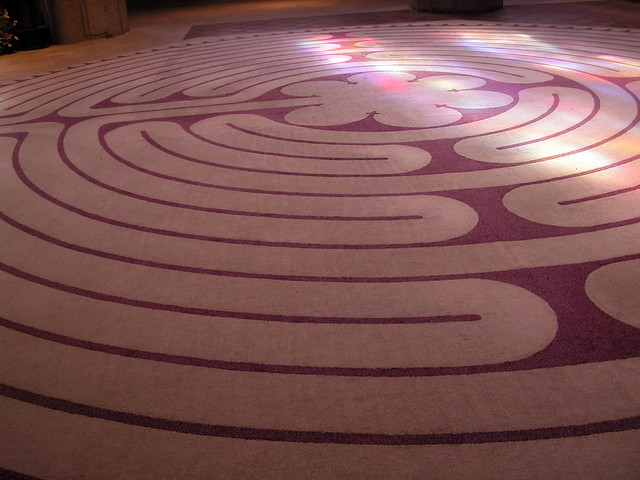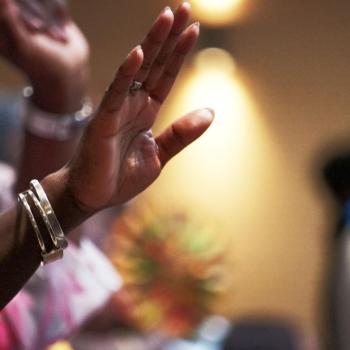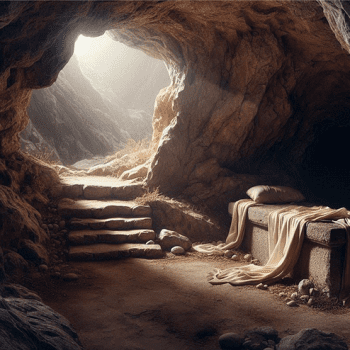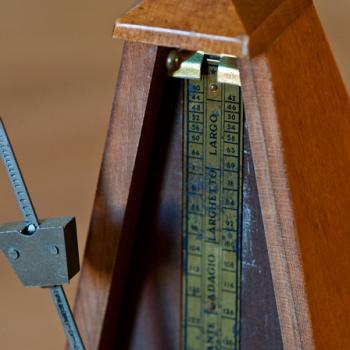
Walking Our Own Everyday Labyrinths
Some people find labyrinths a little confusing. They are afraid they might get lost, run into other people, or get in someone else’s way.
There are people who are concerned because they do not understand how labyrinths work or who built the first one.
I have walked and prayed labyrinths in churches and monasteries. There is one in a public garden within walking distance of where I live. Many churches and other accessible spaces have labyrinths available to the public. I attended a wedding at Grace Cathedral in San Francisco on the indoor labyrinth there. Some churches and other spaces have moveable labyrinths they unfurl at specific times of the year.
A labyrinth is not the same thing as a maze, not a puzzle to solve or a challenge to meet. Labyrinths are a form of walking prayer which traditionally follow a pattern of three parts.
The first part is our journey inward. We start at the edge of the labyrinth and slowly, quietly make our way into it. It is a deliberate, contemplative process of taking one step at a time. There is plenty of time for breathing, listening, and calming ourselves.
The second part of the labyrinth is when we spend time at the center. We stand or sit at the labyrinth’s center to listen to sacred stillness until we are ready to leave.
The third part of our practice is our journey outward. We have listened and spent centered time and now return to a world which waits for us.
We may start on the edge of the labyrinth, but there is no beginning and no ending. Our journey in the world brings us to the edge of the labyrinth and continues as we walk away.
There are no rules about where truths are waiting for us.
Can We Find Everyday Labyrinths?
I know people who look for labyrinths. They go out of their way, traveling significant distances, to find one they have not walked before.
It is easy for me to understand their quest to collect as many labyrinths as they can find. Each one is unique and many of them are in beautiful places.
The labyrinths I walk and pray most often are not in stunning surroundings. I seek everyday labyrinths.
Walking is important to me. I walk whenever I can. I relate to other people differently when I walk than when I drive.
We all walk at our own pace. Sometimes we amble along, sometimes we stride with purpose. Walking gives us time to reflect, to breathe well, and to pray.
My praying is fairly intentional as I begin to walk. There may be a subject or person drawing me out to walk and pray for them. Sometimes I pray through my schedule or the time I will spend with people.
Walking prayer is praying with our eyes open. We see the people who might be living on the streets, the people who are waiting for a bus. Walking prayer may be filled with the spiritual life of construction sites, of hospitals, of coffee shops.
We pray for the people and places we see and know.
The days I walk become everyday labyrinths. I begin a journey inward, find time and space to spend some centered time, and head back out into the world.
We do not need to walk and pray in a cathedral or at a spot overlooking the ocean. Our everyday labyrinths do not need to be clearly marked. No one else needs to know we are walking and praying.
Our journey is more significant than our surroundings.
A Practice of Everyday Labyrinths
We may find traditional prayer postures of sitting or standing still or kneeling challenging. It is easy for us to become distracted and anxious about whether we are doing it the right way.
The essential element of prayer is listening and being open to spiritual life.
Spiritual life is all around us and within us, wherever we walk. It fills our everyday life with deeply sacred truths. So many things which are less important and less meaningful compete for our attention.
There are so many other things we could be thinking about or working to accomplish. People and places familiar to us remind us of what we have done in the past or hope to do in the future.
Walking prayer gives our bodies something to do without drawing our minds away from the present moment.
We may want to begin our practice of everyday labyrinths by finding a labyrinth to walk today. Find the labyrinth closest to you and give yourself an understanding of what they are like. Look for a picture of a labyrinth and figure out how you will walk and pray your everyday labyrinths.
The most challenging part of everyday labyrinths for most of us is taking our first step.
Everyday Labyrinths for Today
There are many ways we can choose to practice everyday labyrinths.
Some of us walk long distances on pilgrimages to places we find sacred. We may pray as we take part in marches or other demonstrations. Some of us find prayer and communion with spiritual life as we hike in wilderness spaces.
We may pray as we take meals to hungry people or visit people who are sick or imprisoned. Some of us pray as we help people with nowhere to live other than on a sidewalk.
Other people take a walk when we need to clear our heads or our hearts, to calm down or catch our breath. Some of us pray as we march or run or ramble. There are people who pray on a treadmill.
We pay attention in the present moment and begin our practice of everyday labyrinths.
I will be heading over to the public garden this afternoon and continue my practice of everyday labyrinths. The labyrinth in that garden is a centering place in a larger everyday labyrinth.
How will we practice everyday labyrinths today?
Where will our everyday labyrinths allow us go this week?
[Image by giopuo]
Greg Richardson is a spiritual life mentor and coach in Southern California. He is a recovering attorney and a lay Oblate with New Camaldoli Hermitage near Big Sur, California. Greg’s website is StrategicMonk.com, and his email address is [email protected].
















